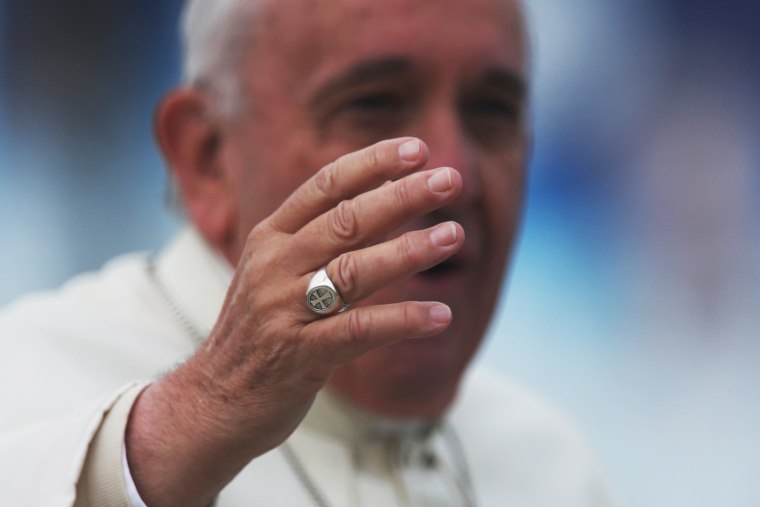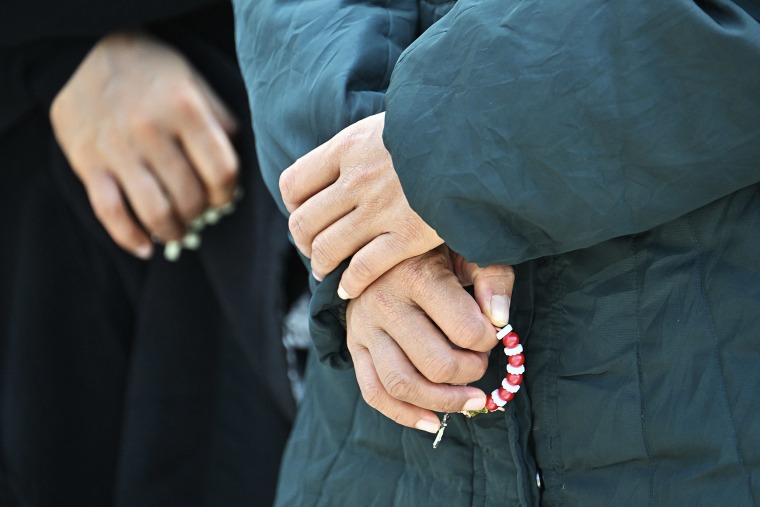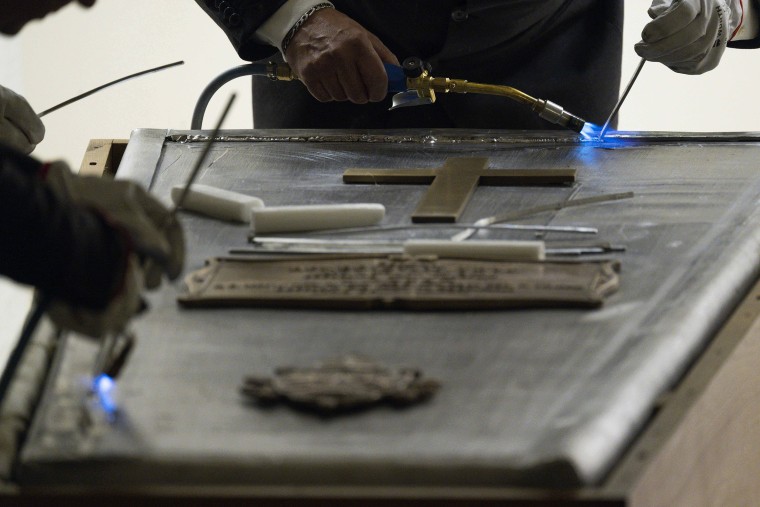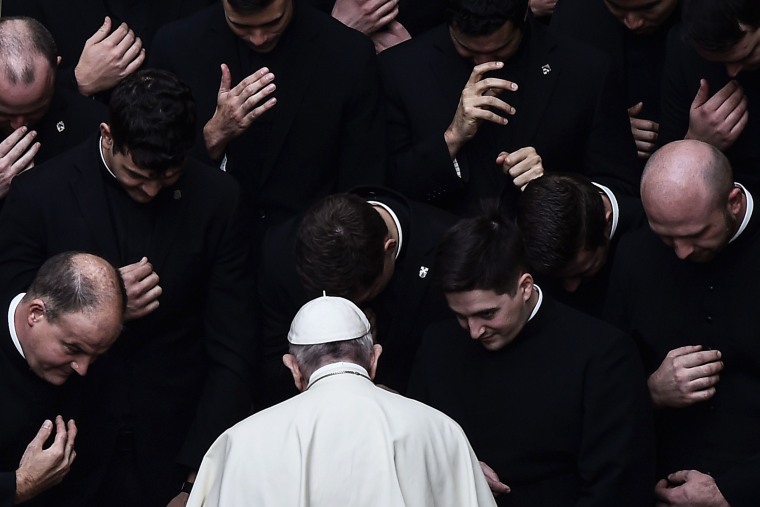In life, Pope Francis strayed from the more conservative path forged by his predecessors Pope John Paul II and Pope Benedict.
But in death, Francis will be following in many of John Paul’s footsteps.
The demise of the first Argentine to lead the Roman Catholic Church set into motion a series of rituals, some of which go back more than 2,000 years and have been used to bury more than 250 popes.
They are compiled in a more than 400-page tome called the “Ordo exsequiarum Romani pontificis,” which includes the liturgy, music and prayers used for papal funerals over the centuries.
“The Ordo covers the rituals that are followed from the moment a pope dies to the moment a pope is buried,” said the Rev. David Collins, an associate professor and the director of Catholic studies at Georgetown University.
But in accordance with his wishes, Francis is expected to be buried at the ancient Basilica of St. Mary Major, which lies outside the Vatican’s walls.
The Vatican laid out plans for the body of Pope Francis on Monday, saying that he will be placed in his coffin later the same night.
“His Most Reverend Eminence Cardinal Kevin Joseph Farrell, Camerlengo of the Holy Roman Church, will preside over the rite of confirmation of death and the placing of the body in the coffin,” the Vatican said in a statement.
The rite will take place in the Chapel of the Domus Sanctæ Marthæ.
His body could be moved to St Peter’s Basilica as early as Wednesday to allow his worshippers to pay their respects, the Vatican said, adding that a formal decision on the issue would be made by a group of cardinals during a meeting on Tuesday.
The playbook for Francis’ funeral will also draw from a 20-page document called the “Universi Dominici Gregis,” which is Latin for “The Shepherd of the Lord’s Whole Flock” and was issued by John Paul in 1996, Collins said.
“This, essentially, lays out the procedures for what happens after a reigning pope dies between the death of one pope and the election of his successor, a period called the papal interregnum,” Collins said.
Those were the rules that were in place during the send-off of John Paul, who died April 2, 2005, and was buried six days later. During those six days, millions of people filed past his coffin in St. Peter’s Basilica, and there was a funeral attended by presidents and monarchs. Because Benedict resigned and was not the pope when he died, Francis’ ceremonies will more closely resemble John Paul’s.
This is what happens during the interregnum, which started with Francis’ death and will last until the College of Cardinals chooses a new pope:

Day 1
The papal chamberlain, or camerlengo, Irish-born Cardinal Kevin Farrell, who is also the former bishop of the Diocese of Dallas, temporarily takes over the reins of the church. But his first task is to confirm that Francis is dead.
“In this case, as in the case of the last several popes, doctors would be on hand to make the call,” Collins said. “The camerlengo is there to ensure this happens.”
There is an enduring myth, which has been accepted in some places as fact, that a pope’s death is confirmed by tapping on his forehead with a ceremonial hammer while calling out his baptismal name three times.
But Notre Dame theology professor Ulrich Lehner said, “The hammer episode is an old tale which is not mentioned in any official text.”
Tradition holds that once death is confirmed, the camerlengo announces in Latin to everyone around the deathbed that the pope has passed away.
“Vere, Franciscus mortus est,” or “Truly, Francis is dead,” Farrell would say.
But because the pope is also the bishop of Rome, it becomes the responsibility of the chief administrator of the Diocese of Rome “to announce to the city of Rome that the pope is dead,” Collins said.
“That has the effect of telling it to the world,” Collins said.
Church bells toll in St. Peter’s Square and across Rome, and the white-and-gold Vatican flags will be lowered to half-staff. Emails will be sent out to summon the cardinals to the Vatican.
While that is going on, “the camerlengo will be securing the room, taking an inventory of the items, determining whether there is a last will or testament among the pope’s effects, things like that,” Collins said. “The camerlengo also authorizes the death certificate, seals the pope’s room and posts a guard outside to secure the premises.”
Meanwhile, Francis will be clad in his funeral garments.
“Usually, for a funeral, vestments can be white or black or even purple,” Collins said. “In the case of a pope, the deceased pope will be vested in red over his white cassock. The clergy who officiate at the funeral Mass will also wear red vestments.”
In addition, the camerlengo takes control of the papal ring, known as the Fisherman’s Ring, which used to be ceremonially smashed, when the cardinals arrive to pick a new pope to symbolize the end of Francis’ papacy, the experts said.
“The original purpose of this was to prevent forgery and ensure that nobody used the papal ring to seal a false document,” Collins said.
Once a new pope is chosen, another ring will be struck bearing the name of Francis’ successor surrounding the image of St. Peter casting a fishing net.
Back in the day, the Vatican would mint coins and produce medals commemorating the Sede Vacante, or the period during which there is no pope. The money generated by the sales of such items would help pay for the papal funeral.
Collins said that’s not happening here.
“The period without a pope is not that long,” Collins said. “For example, the interregnum between John Paul II and Benedict XVI was less than three weeks. And in any event, Vatican uses the euro now.”

Day 2
The day after the death, a group called the College of Cardinals gathers in what is known as the general congregation to discuss the plans for the pope’s funeral and the process of choosing a successor. All the church’s cardinals who can take part in the election council, which can trace its roots to 1059, will do so.
The group must decide the date of the funeral. In 2005, John Paul II’s funeral was six days after his death, and the conclave to choose a successor met 10 days later.
It must also decide when the pope’s body can be taken to St Peter’s in the Vatican, where it will lie in state as part of the “Novemdiales,” a nine-day period of mourning that dates back to ancient Rome.
The funeral Mass must take place four to six days after the pope’s death.
The conclave, the cardinals who will elect the next pope, must meet 15 to 20 days after his death.
The historic reasons for the long delay were to get cardinals to Rome from different parts of the world. But in a more geographically diverse church, it still has its uses.
“To some extent that long period is relevant now: Even though the cardinals can jump on a flight, Pope Francis has appointed more cardinals from different parts of the world than ever before. They will come from Oceania, from Latin America, there are now cardinals from Myanmar, Tonga and Mongolia, for example,” said Deborah Lubov, NBC News’ Vatican analyst.
“Historically, cardinals have primarily come from Europe and the United States, but the church is declining in these places, while in places like Asia it’s booming. You could see that reflected in the College of Cardinals and then possibly in the pope’s successor.

Preparing the body
The pope’s body will be placed in three caskets: one made from cypress, the second from metal and the third from elm or oak.
Alongside him will be several symbolic items, or vestments. They include the miter, the pope’s pointed hat, and the crozier, or pastoral staff, signifying the pope’s role as the “pastor of all the pastors.”
After the pope is blessed with holy water, his face is covered in white silk. A small bag of coins minted during his reign is also placed in the coffin — John Paul II was buried alongside 26 coins, one for each year of his reign.
A legal document called a rogito, which records the pope’s life and works, is then read out and signed by all those present before it is placed in the coffin. A second copy goes to the Vatican’s archives.
Traditionally, popes are buried holding a rosary, a death certificate and the broken fisherman’s ring.
The body may or may not be embalmed. John Paul II’s was not, but it was treated so it would be preserved during public viewing. The body of Pope John XXIII was also not embalmed on his death in 1963, but it was treated with preservatives that were so effective that his face was perfectly preserved when the casket was opened and moved to a new resting place in 2001.
The coffin is finally sealed before an audience of senior Vatican officials and cardinals, who all then sing Psalm 42, which reads: “Like the deer that yearns for running streams, so my soul in longing for you, my God.”

The funeral
Before the funeral, the pope’s body is expected to lie in state at St. Peter’s Basilica for three days. Regardless of where the pope dies, the funeral always takes place at the Vatican, specifically in St. Peter’s Square, weather permitting.
The 2½-hour service is mostly held in Latin. It will for the most part be a conventional Catholic funeral, but with added papal rituals.
The Swiss Guards, who have protected the pope and the Apostolic Palace since 1506, will kneel for the consecration of the host, the blessing of the bread and wine that, according to Catholic tradition, then become the body and blood of Jesus Christ.
A homily or sermon will be delivered that will refer to the life of the pope — but technically it is not a eulogy.
The event requires a huge security operation. An estimated 4 million people thronged the streets of the Vatican during John Paul II’s funeral in 2005, alongside 8,000 security staff members, including 2,000 uniformed police officers and 1,400 plainclothes officers.
After the service, the body is carried through the “door of death” to the left of the altar at St. Peters, while a 10-ton funeral bell tolls. The congregation’s chants include lines from Psalm 117 (“Open to me the gate of justice”) and Psalm 41 (“In the splendid company of the saints, I will go to the house of God”).
Breaking with recent tradition, Francis requested that he be buried at the Basilica of St. Mary Major, citing his “very strong connection” with the ancient church, which lies outside the Vatican walls.
Collins pointed out that he might not get his wish.
“Popes could leave other instructions in their last testaments to be buried elsewhere. John Paul specifically asked that his body be returned to Poland. But the cardinals said no, and he was buried in the Vatican,” he said.
“As with John Paul II, this is a case where the pope does not have the last word.”
Normally, a papal “family” of senior cardinals and officials leads a procession to the crypt, which houses the remains of 148 popes, out of a total of more than 260.
The cypress coffin is bound with red ribbon featuring the seals of the camerlengo’s office and other branches of the papacy before it is placed into the metal coffin, which is then soldered closed. The whole thing is placed into the elm coffin and finally lowered into the crypt.

The conclave
This secretive council of cardinals has met in the Sistine Chapel to vote for the next pope since 1878. Up to 120 cardinals can take part, but each must be younger than 80 on the day they conclave opens. The conclave will meet 15 to 20 days after the pope’s death.
The word, which comes from “con clave,” Latin for “with key,” dates to 1274, when Pope Gregory X said electors should be locked away and unable to leave until they had chosen a new pope.
Each elector swears an oath to protect the church’s freedom and the secrecy of the conclave. As the last oath is complete, the master of ceremonies chants “Extra omnes,” meaning “Everyone out.” Electors are now forbidden from accessing the outside world — in 2013, some electors said their temporary goodbyes to the world on Twitter.
The last conclave in 2013 elected Pope Francis, who until then was known as Jorge Mario Bergoglio.
The first vote happens on the first day the electors are in the Sistine Chapel, and voting continues with four ballots every day until on the fifth day the cardinals pause for a day of prayer.
The next day the voting continues, and after the sixth day of conclave there will have been up to 17 votes — and that continues for as long as necessary until there is a two-thirds majority.
The cardinals are allowed to leave at the end of each day, and they will stay at the Casa Santa Marta, a $20 million guesthouse on the grounds of the Apostolic Palace that looks more like an upscale hotel. All staff members are required to take an oath of secrecy.
Two stoves are placed near the chapel entrance — one to issue black smoke, meaning there has been no successful election yet, and one to issue white smoke, meaning a new pope has been chosen.
The current stove system, which was first used in 1939, stretches from the chapel floor to its roof 98 feet above.
Bells and smoke are the only permitted ways to communicate the election of the pope. During the last papal conclave in 2013, a white seagull stepped on the external part of the chimney right after black smoke was emitted, amusing TV audiences around the world before it flew off 30 minutes later.
“In recent history, it’s not typical for the conclave to last too long, because it’s a symbol of the trust in the winning candidate. If it goes on it automatically, gives the impression that there is not a lot of certainty in this person,” Lubov said.

Choosing a new pope
At last, when a new pope is chosen the dean of the College of Cardinals asks him: “Do you accept your canonical election as supreme pontiff?” From the moment the candidate-elect says “Accepto,” he is the new pope.
From that moment the pope is not just the leader of the Catholic church but also the leader of the world’s smallest state, Vatican City.
The dean then asks by which name the new pope would like to be known. John is the most popular name in papal history; it has been used more than 20 times.
Traditionally, the new pope is then taken to a small sacristy behind the Last Judgment wall of the Sistine Chapel. It is sometimes referred to as the “Room of Tears,” because some newly elected popes are said to have become overwhelmed by their elections and broken down in tears.
While there, the new pope puts on three cassocks and receives his fisherman’s ring before he returns to the main chapel and receives the prayers of thanksgiving from the cardinal-electors.
At that point, the bells of St. Peter’s will have rung and the famous white smoke will have risen from the Sistine Chapel’s chimney to signal the election of a new pope.
Normally, within a week of the election, the church holds an installation Mass, which will be attended by heads of state and all cardinals. It is largely symbolic, as the new pope has already been elected, but it’s an important statement of the Catholic Church’s reach and importance across the world.

